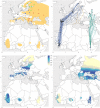Unravelling migration connectivity reveals unsustainable hunting of the declining ortolan bunting
- PMID: 31131318
- PMCID: PMC6530999
- DOI: 10.1126/sciadv.aau2642
Unravelling migration connectivity reveals unsustainable hunting of the declining ortolan bunting
Abstract
In France, illegal hunting of the endangered ortolan bunting Emberiza hortulana has been defended for the sake of tradition and gastronomy. Hunters argued that ortolan buntings trapped in southwest France originate from large and stable populations across the whole of Europe. Yet, the European Commission referred France to the Court of Justice of the European Union (EU) in December 2016 for infringements to legislation (IP/16/4213). To better assess the impact of hunting in France, we combined Pan-European data from archival light loggers, stable isotopes, and genetics to determine the migration strategy of the species across continents. Ortolan buntings migrating through France come from northern and western populations, which are small, fragmented and declining. Population viability modeling further revealed that harvesting in southwest France is far from sustainable and increases extinction risk. These results provide the sufficient scientific evidence for justifying the ban on ortolan harvesting in France.
Figures


References
-
- Boyce M. S., Sinclair A. R. E., White G. C., Seasonal compensation of predation and harvesting. Oikos 87, 419–426 (1999).
-
- Maxwell S. L., Fuller R. A., Brooks T. M., Watson J. E. M., Biodiversity: The ravages of guns, nets and bulldozers. Nature 536, 143–145 (2016). - PubMed
-
- Benítez-López A., Alkemade R., Schipper A. M., Ingram D. J., Verweij P. A., Eikelboom J. A. J., Huijbregts M. A. J., The impact of hunting on tropical mammal and bird populations. Science 356, 180–183 (2017). - PubMed
-
- E. Fuller, The Passenger Pigeon (Princeton Univ. Press, 2015).
-
- Kamp J., Oppel S., Ananin A. A., Durnev Y. A., Gashev S. N., Hölzel N., Mishchenko A. L., Pessa J., Smirenski S. M., Strelnikov E. G., Timonen S., Wolanska K., Chan S., Global population collapse in a superabundant migratory bird and illegal trapping in China. Conserv. Biol. 29, 1684–1694 (2015). - PubMed
Publication types
MeSH terms
Substances
LinkOut - more resources
Full Text Sources

